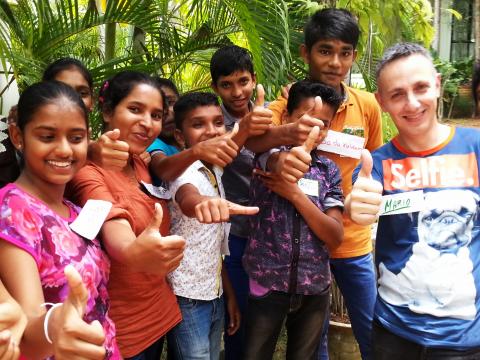Children’s voices in times of COVID-19

By Mario Stephano, Advisor, Child Participation, World Vision International
In times of crises, wars, hunger, and pandemics, everybody, without exception, is affected. Everyone expresses the same fears, concerns, and worries about their lives, what tomorrow will bring and how this will end.
People deal with stress in many different ways, but one commonality is the concern for how they can protect children and keep them safe. However, despite this valid concern, many adults view it through a paternalistic lens and often see them as defenceless, vulnerable victims. However, in my experience, children and young people have the agency and ability to deal with challenging contexts in a manner that is sometimes better than how adults handle the same situations.
In my 20 years in the children’s rights field, I have met many children and young people from different religions, ethnicities and backgrounds from all continents and I have learnt a lot from them. For instance, I understand that children are not vulnerable human beings who just need adults’ help and attention. They might need our support in many aspects of their lives but this does not exclude them from having their own views, ideas, ways of thinking or problem-solving methods.
Due to the COVID-19 outbreak, and as part of our mandate as a child-focused organisation, we consulted children and young people to explore how their lives have been affected by this global health crisis and how they can engage virtually to raise awareness to stop the spread of this pandemic. We spoke to 101 children and young people across 13 countries. They demonstrated that, despite the difficult times, lockdowns and health hazards they are facing, they are able to be agents of change and hope.
Reaching children and young people in times of COVID-19 was a struggle as they are out of school, not going to their community centres, and may not have access to the Internet. Furthermore, we were unable to conduct focus group discussions, one of our preferred methodologies, due to physical distancing mandates. Then we realised that we could conduct an intergenerational research study with our existing network of young leaders across different countries. When I explored this option with them to gauge interest, they all agreed immediately. I was initially worried that this would be a burden on them. But, to the contrary, they told me that this consultation was an opportunity for them to feel useful during the lockdown. They each reached out to five or six peers, transcribed and translated responses and followed up with me to ensure that we had everything we needed for the report.
This consultation would not have been possible without the 12 young co-researchers who assisted me. Their involvement helped us reach our target audience, which would have been impossible otherwise. We, the adult researchers, consider the participating children and young people to be our equitable partners in this research project and this view was reflected in the way we worked with them.
It is also important to mention that the young leaders in many of the countries had previously been trained on child-led research skills. Last October, I travelled to Bosnia and Herzegovina to train young leaders on how to conduct child-led research. Before that, I supported a group of Syrian refugee children and young people in Lebanon and Jordan to conduct a child-led research study on their experiences in their host countries. In both cases, I was utterly impressed by how they selected their topics, understood the methodologies, developed research questions, collected data and wrote up their research reports.
If you are wondering what our findings were from this research, it revealed how children and young people have turned this harsh time into something positive and meaningful by volunteering to raise awareness with local authorities about the coronavirus and how to stay protected, producing masks to give to those in need and sharing great ideas on how to use social media to stay connected and spread awareness amongst their peers and parents. Please read our report here.
Lastly, throughout the engagement on this project, we were proud of our co-researchers who proved, once again, that they are not just beneficiaries or helpless victims; they can lead the way on issues that affect their lives and change the traditional ways of how children and young people are portrayed.